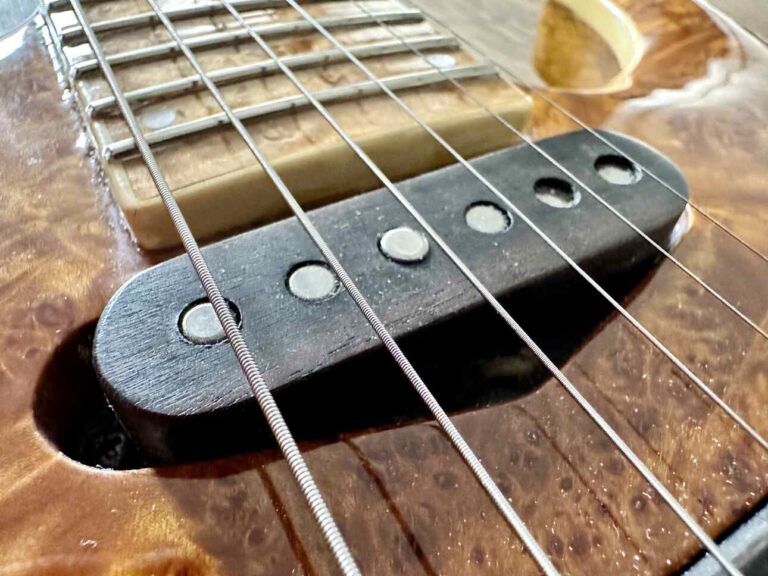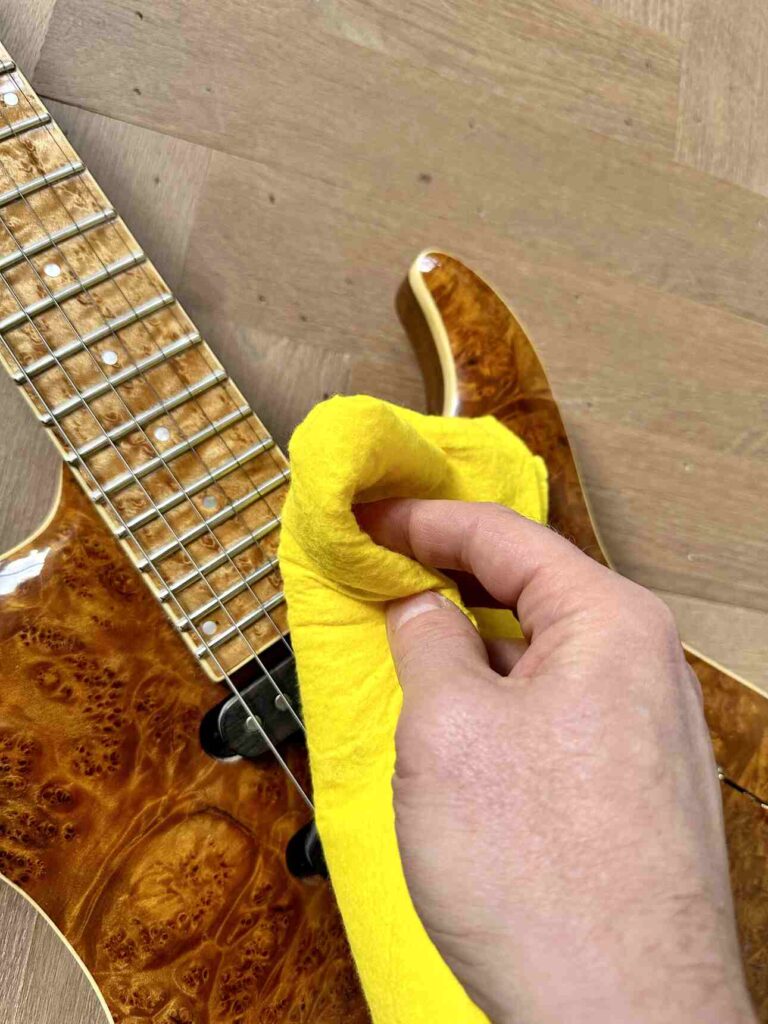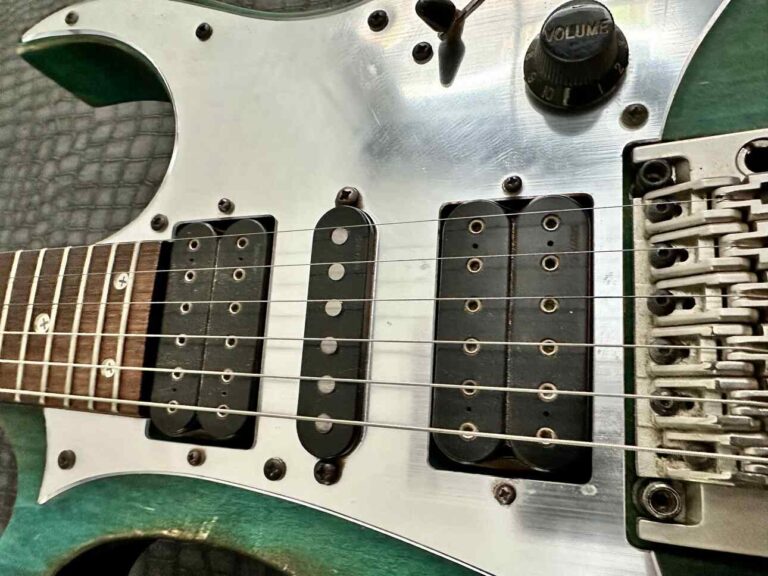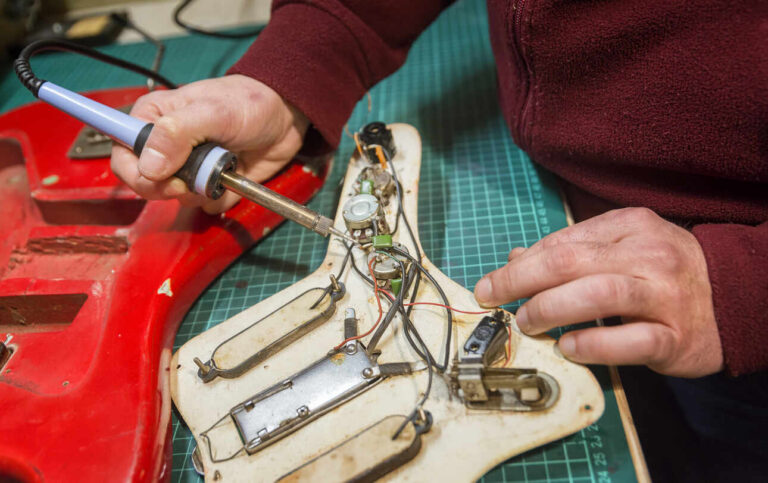SSS versus HSS Guitar Pickups: Choosing Your Perfect Sound
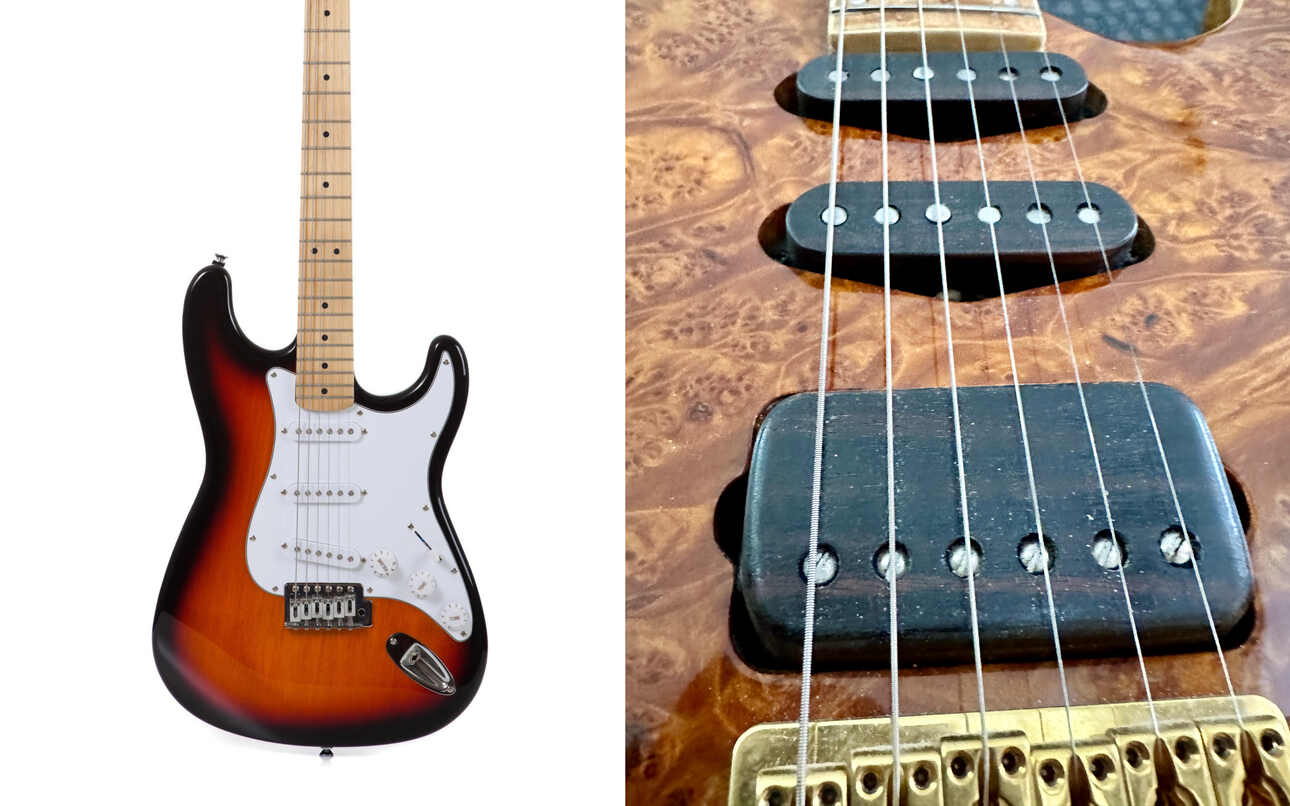
You’ve got common setups in electric guitar pickups. Two are HSS (humbucker at the bridge, two single coils) and SSS (three single coils). They each bring their own sound to the table.
HSS stands for a humbucker-single-single configuration, and SSS stands for a single-single-single configuration. In other words, these two abbreviations are about the mix of pickups on a guitar.
Choosing the right one for you hinges on understanding their unique traits and how they complement your playing approach.
Take the iconic Fender Stratocaster, for example – it’s equipped with an SSS array. This trio is famed for its sharp, clear notes that really shine in blues, rock, and country tunes.
Switching gears, the HSS setup throws a humbucker into the mix at the bridge, dialing up the versatility. It’s a go-to for those chasing thicker, more potent vibes, fitting like a glove for hard rock and metal jams.
Key Takeaways
- Pickups are pivotal in defining an electric guitar’s tone, with HSS and SSS as favored setups;
- SSS pickups, found in Fender Stratocasters, deliver sharp, vibrant sounds well-suited for blues, rock, and country music;
- HSS pickups, with their humbucker component, provide diverse tones that cater to dense, rich musical styles, perfect for hard rock and metal.

Understanding Guitar Pickups
The Role of Pickups in Guitar Tone
As a guitarist, your instrument’s sound is a big part of what makes your style unique. The pickups are key in shaping that sound.
These parts take the strings’ vibration and turn it into an electrical signal. It is then sent down the guitar cable to your amp.
Now, let’s dive into the two main pickup types you’ll encounter: single coil and humbucker.
Types of Guitar Pickups
Single Coil Pickups: Recognized for their sharp, clear sound, single coil pickups are a staple on guitars like the Fender Stratocaster.
They work with a single wire loop around a magnet, capturing string vibrations as a magnetic field. But they can be sensitive to electrical interference, leading to a “60-cycle hum.”
Humbucker Pickups: Named for their ability to cancel out the hum that single coils pick up. Humbuckers use two coils of wire and a magnet for a richer, warmer output.
You’ll see these on guitars like the Gibson Les Paul.
The HSS setup, with a humbucker at the bridge, is great for a heavier sound for rock or metal. With its trio of single coils, the SSS offers a sound that adapts well to a range of styles like blues, jazz, and country.
By exploring different pickup combinations, you can broaden the sonic range of your guitar. It’s all about finding that ideal match for your musical expression and the tones you’re after.
Comparing HSS and SSS Configurations
Choosing a guitar often comes down to the pickup configuration. This is crucial for your instrument’s sound and versatility.
The HSS and SSS setups are widely chosen.
The HSS configuration, with its humbucker at the bridge, is a powerhouse for heavier tones. That’s why it’s a favorite for rock and metal players. The humbucker offers a thicker, more saturated sound. And it can handle high-gain settings well.
On the flip side, the SSS setup is all single coils, known for their clarity and brightness. This configuration is a classic choice for genres like blues, jazz, and country, where a cleaner, more articulate tone is often preferred.
When deciding between the two, consider the HSS if you’re after versatility and a sound that can handle both heavy riffs and lighter passages. Opt for the SSS if you’re into genres that require crisp, clean tones. Basically genres that want the quintessential Stratocaster sound.
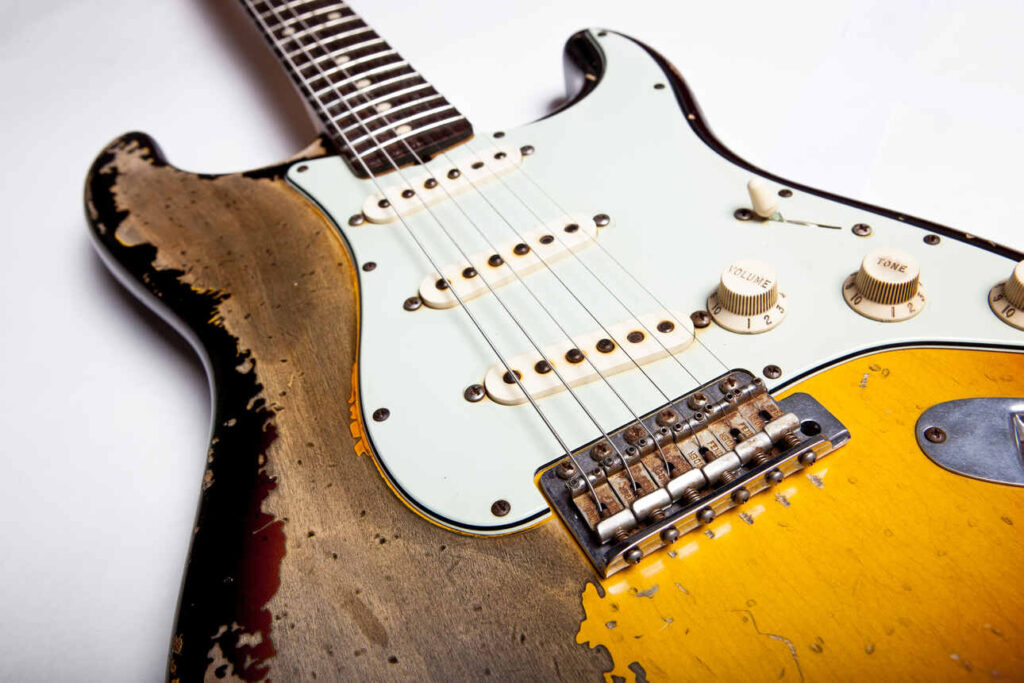
Sound Characteristics
The key difference between HSS and SSS configurations is the humbucker in the HSS setup. It delivers a richer, warmer sound.
Single coils, conversely, offer a more piercing, clear tone.
HSS:
- Bridge: Humbucker – Delivers a robust, full sound;
- Middle: Single-coil – Offers a balanced tone with a touch of brightness;
- Neck: Single-coil – Known for its clear, ringing quality.
SSS:
- Bridge: Single-coil – Produces a sharp, snappy sound;
- Middle: Single-coil – Maintains balance with a hint of brilliance;
- Neck: Single-coil – Provides a mellow, rich tone.
Typical Uses in Music
Please understand that HSS and SSS pickup configurations are versatile across genres. Their tonal qualities, however, lend themselves to particular musical styles.
HSS:
- Rock: The humbucker’s robust sound is a perfect match for the intensity of hard rock and the depth of classic rock;
- Blues: The combination of the warm tones from the neck and middle single coils can create the soulful sound that blues is known for;
- Versatility: This setup is a jack-of-all-trades, offering the fullness of a humbucker and the clarity of single coils.
SSS:
- Vintage Style: Iconic players like Jimi Hendrix, John Mayer, and Stevie Ray Vaughan are known for the crisp, clear tones of this setup;
- Country: The bridge single coil’s sharp twang is a staple in country music;
- Funk: The distinctive ‘quack’ from the mixed positions of the pickups is ideal for funky rhythm parts.
Choosing Between HSS and SSS
When you’re picking between an HSS and SSS setup, think about these points:
- Music Genre: Go for HSS if your music demands the bold impact of a humbucker, like in rock. Choose SSS for the crisp, clear tones ideal for country or funk;
- Versatility: An HSS rig might be your best bet for flexibility. It offers the warm depth of a humbucker and the crispness of single coils;
- Preference: What you like is what matters most. It’s that simple. Pick the configuration that delivers the sound that excites you.
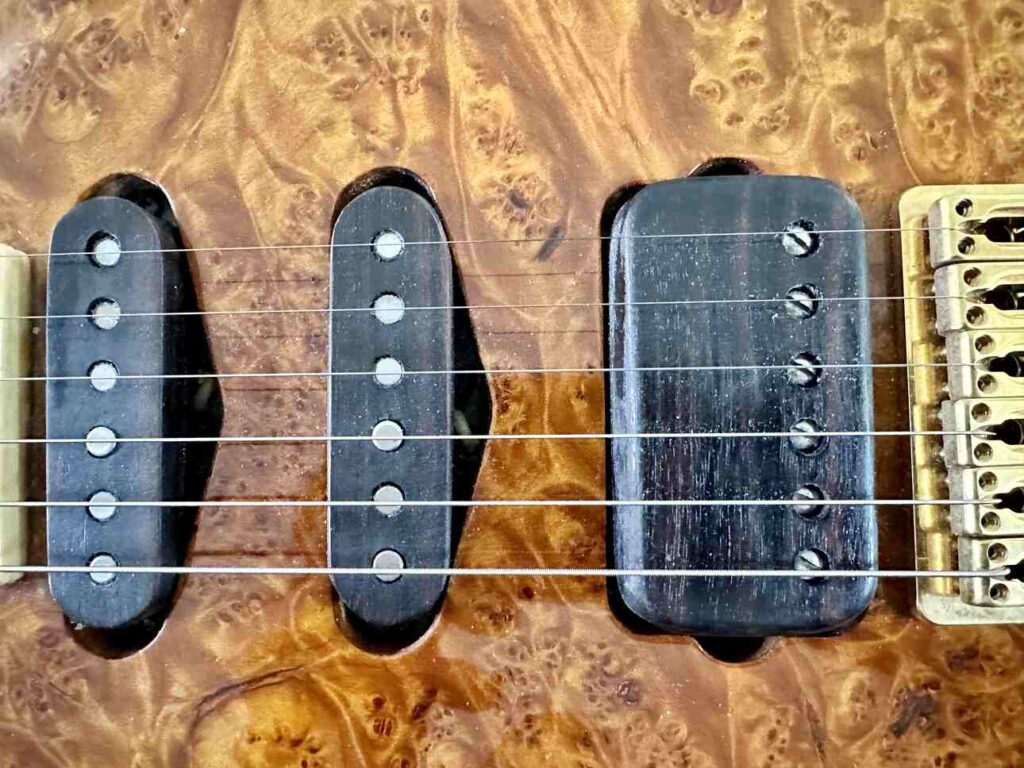
Technical Aspects of HSS and SSS
Positioning and Electrical Components
When weighing the options between an HSS and an SSS configuration, consider the placement and electrical nuances.
With an HSS setup, the humbucker is at the bridge, which differs from an SSS, where all positions have single coils.
Humbuckers cancel the hum from electrical interference, hence their name. They produce a warm, full sound and offer better noise cancellation. Single coils, on the other hand, are more prone to picking up noise.
Here’s a quick breakdown:
- Humbucker (HSS): Positioned at the bridge for a rich, resonant tone with excellent hum reduction;
- Single Coil (SSS): Occupies all positions, delivering a sharp, clear sound with less noise cancellation;
- Single Coil (HSS): Found in the neck and middle for that classic single coil brightness, but with lower hum cancellation than the humbucker.
Installation and Modification
Switching your guitar’s pickup configuration from HSS to SSS or vice versa can require some work.
If you’re fitting a humbucker into a single coil slot for an HSS setup, you’ll need to create space in the guitar body to accommodate the bigger humbucker.
Luckily, you can opt for a humbucker sized like a single coil. Like the DiMarzio Rail Hum pickups. This way, you avoid the need for significant changes.
Converting an HSS to an SSS can be simpler. There’s more than enough space to fit a single coil into a humbucker slot. The only disadvantage is that you’ll always see that there used to be a humbucker there.
It’s good to know that swapping pickups isn’t just about physical fit. It also involves soldering and wiring. If you’re not sure how to do this get a skilled guitar tech on board to help out.
Practical Considerations for Guitarists
Maintenance and Care
Start by removing dust from your pickups with a soft brush or cloth. Make sure your guitar is disconnected from any amps first.
For tougher dirt, a lightly dampened cloth can do the trick. Avoid harsh cleaners or too much moisture. They can harm the pickups.
Upgrading from SSS to HSS
Changing your guitar from SSS to HSS can give you more types of sounds to play with.
The humbucker in the HSS setup can be a game-changer.
Here’s how you can approach the upgrade:
- Research: Dig into different HSS pickups to find the one that fits your sound goals. Check out reviews and ask for advice from seasoned players or your local guitar shop expert.
2. Installation: If you’re savvy with guitar tech, you might follow online guides to install the pickup yourself. If not, it’s smart to get a pro to handle the installation.
3. Test & Adjust: Post-installation, play your guitar to see how it feels and sounds. Tweak settings as needed to dial in the tone you’re after.
Upgrading to HSS takes time and effort, but the benefit is a wider variety of sounds.
Frequently Asked Questions
Should beginners opt for HSS or SSS pickups when choosing their first guitar?
For new players, the choice between HSS and SSS pickups should reflect the music you’re drawn to. If rock or heavier music is your jam, an HSS setup with its versatile humbucker might be the way to go. But an SSS configuration can give you those classic Strat sounds if you’re all about classic rock, blues, or jazz.
How does switching from SSS to HSS impact the classic Stratocaster sound?
Altering your Strat from SSS to HSS will indeed tweak its signature sound. The humbucker brings a beefier, warmer quality. It expands your tonal options, especially for high-gain settings. Yet, this switch might dial down the iconic Strat ‘chime’ and articulation. It boils down to your taste and the sonic versatility you’re after.
In what situations would HSS pickups outperform SSS pickups?
HSS pickups often shine when you’re cranking up distortion or overdrive. This is thanks to the humbucker’s ability to deliver a fuller sound that’s less noisy under high gain. They also offer a wider tonal palette. They blend the warmth of a humbucker with the clarity of single coils. This makes them versatile for various musical settings.
Can you achieve heavy distortion with SSS pickups, or is HSS the better choice?
Yes, you can get heavy distortion with SSS pickups. Still, if you’re aiming for a thick, saturated distortion, HSS is often the preferred choice. The humbucker in HSS can take high gain without losing definition. It gives you a solid, tight distortion, especially in the bass frequencies. While capable of distortion, SSS setups tend to be noisier. They may lack the sustain and fullness that heavy distortion requires.

